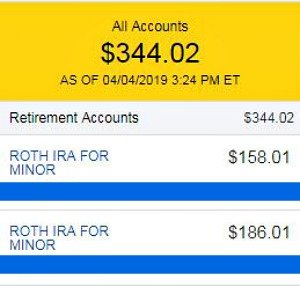As parents and a family on the path to Financial Independence, we want to teach our kids as much as we can. I don’t know about you, but my I kick myself in the butt all the time for my past financial mistakes. Mistakes I didn’t even know I was making!
While my parents taught me more than most of my peers about finances, there was still a lot that was lacking. We don’t want to make the same mistake with our kids. So we are doing everything possible to teach them the things we didn’t know then that we know now.
Opening a Roth IRA for kids is one of the biggest tools we have added to our arsenal to teach our kids about Financial Independence. And so far, it has been one of our most effective.
If your child has “earned income”, meaning income they earned working, then they are eligible to open a Roth IRA for kids. Accounts can be opened at Fidelity and Schwab.Can You Open A Roth IRA For Kids
Whether or not you can open this type of account for your child can be the trickiest part of the whole lesson. This is because the broad answer is yes. But, ultimately, your child needs to have “earned income” in order to have a Roth IRA for kids opened in their name.
Earned Income
Earned income is anything that your child has worked for to earn money besides regular household chores.
There are a few ways that your child can do this:
- You are a sole-member LLC and they do actual work for your company
- You have a partnership, where you and the partner both claim the child as a dependent, and the child is doing actual work for the partnership
- They work for somebody else and receive a real paycheck, either as a W-2 employee or a 1099 self-employed contractor (Note: the latter will end up costing them more of their paycheck in the long run due to self-employment taxes)
There are a couple of perks to the first two options, which are:
- Paying your minor child to do real work through your business reduces your business’s taxable income
- Your child is exempt from paying Social Security and Medicare taxes on this earned income
Since the children already worked for my business, it only made logical sense to start paying them through the business. It not only helps reduce my taxable income but also helps them get one step further ahead.
Listen: How To Fund Your Child’s Roth IRA With The FI Tax Guy
Limits
If they are eligible to open a Roth IRA in their name, then you and others can gift them money towards their nest egg. According to the IRS, the current amount you are allowed you can gift, without being subject to the gift tax, is $15,000 per year.
Related: The Tax Consequences Of Giving Large Sums Of Money
However, the Roth IRA contribution limits are currently $6,000, so you wouldn’t be allowed to gift that much into their Roth IRA in a calendar year.
Since we want them to learn how to earn their own money, and how to make their earned income grow exponentially, gifting too much takes away from the lesson. If we end up gifting them most of the money to put into their Roth IRA’s instead of them earning it, we feel like they are missing that lesson.
I would suggest only gifting the difference between their earned income to get to the contribution limit if you really want to help boost their future financial independence. But everybody does things differently, so do what works best for your family and situation.
How To Open The Account
Opening the account was a bit trickier than we had originally hoped. Since there are still only a few companies offering Roth IRAs for kids, it is a bit difficult to navigate.
Offerings
I was only able to find two companies currently offering these types of accounts, which were Fidelity and Charles Schwab. I contacted Betterment about this, since I am a customer, and they informed me that this is a highly-requested product and is currently in development. While this is great, it didn’t really help me at the time.
I ended up going with Fidelity because I already had an old 401k account through them from a previous employer. But please note, Charles Schwab works the same way and has similar fees as Fidelity. So choose whichever company works best for you.
Since we already have so many different accounts open all over the place, I prefer to streamline wherever I can. It makes my life just a little bit easier to have fewer platforms to deal with.
Related: When And Why Your Child Should Open A Roth IRA
Funding The Account
When I began applying for the accounts, the instructions seemed a bit hazy so I ended up calling Fidelity directly. Ultimately, it ended up being pretty easy to set up once they walked me through which information they were looking for. I had to input both the kids’ information and my information, as the custodian of the account until they reach the age of 18.
The information they required was:
- Name
- Address
- Birthdate
- Phone Number
- Social Security number
- Relationship to the minor
- Email addresses
Once the accounts were approved (which took about 24 hours), the next step was adding a funding account. This is where things got really tricky for me!
IRS Rules About Funding Accounts
Since I was unable to find any clear information regarding where the funds had to come from to prove earned income, I went straight to the source–the IRS.
This isn’t usually my idea of a good time. However, since the few articles I could find didn’t source any rules about the funding accounts, nor could I find information on the IRS website, calling them seemed like the best option.
I spent over an hour on the phone with two different departments to get the answers to my questions. The IRS still has a tendency to flag filings related to children, unfortunately. This is especially true if they are younger and you are paying them out of your business. In cases like these, it’s crucial to know exactly where the lines are. That way, if you’re ever get audited, you’re covered.
After weeding through the IRS code, the IRS expert in the IRA department was finally able to tell me that:
- Only bank accounts with the child’s name on it and into which the earned income was deposited can fund a Roth IRA for kids
- The child can send their paychecks directly to the Roth IRA servicer for direct deposit
- The funds CANNOT come from a parental account as those funds are deemed as a gift and not contributions from earned income
- If, during an audit, it is discovered that the funds deposited into your child’s Roth IRA account did not come from their own account, there are consequences
Based on what I found up on my own prior to this conversation, I was pretty sure this was the case. But I was glad to get IRS confirmation so that I know exactly what must be done to keep everything above-board.
Related: How To Use A Roth IRA For College And Other Expenses
IRS Rules About Paying Your Child
The second department I got passed to was for business and corporate taxes. I wanted to speak with them to make sure I was paying my children correctly through my business. This is two-fold in that I want to get the most tax benefits for both my business and my children.
The IRS agent told me that, in order to avoid self-employment tax, children cannot be paid as vendors; they must be paid as employees.
Usually, if you have employees, you must withhold taxes from their paycheck. But, if you are paying your dependent minor children, you don’t have to to do that!
Minor children are exempt from:
- Medicare taxes
- Social Security taxes
- Federal taxes
They are still subject to paying local income tax.
However, there is a workaround for that. According to the IRS, if they make under $12,000 in earned income per calendar year, they don’t have to file a tax return.
They must also not make anything more than $1,050 in unearned income per calendar year though. Once they do, they will have to file a return. I was told they will probably not have to pay any taxes, depending upon the situation, if they are putting all of their earned income into their Roth IRA.
Children’s EFT Accounts
Now that we have discerned all of the IRS rules, let’s get back to funding the kids’ Roth IRA accounts.
I opened savings accounts at my local credit union for both kids a while ago. Since these are the accounts I use to pay my kids when they work for me, I tried to connect these accounts to fund the Roth IRAs.
This is where the problem came in. Once you add a funding account, it takes 5-7 business days to be approved or denied. After a week, I finally got two denials saying the bank wouldn’t approve EFT (Electronic Funds Transfer) transfers because they were savings accounts only.
I contacted my credit union and learned that my 13-year-old son is old enough to open a checking account. This account would allow EFT transfers, so that worked for his situation. But, according to their rules, my 10-year-old daughter is too young to have a checking account with them. After much back and forth with the manager, they decided there was nothing they could do for her.
Therefore, I had to go to Pinnacle Financial Partners, my business bank, instead. They have worked with me on multiple accounts, so they were more than willing to help. The account we opened is a joint account with me because she is a minor. This works perfectly fine as this was the only way I was able to get around the rule.
Getting an account for your child that has the EFT functionality seems to be one of the biggest issues because a lot of banks won’t give these types of accounts to children. This is especially true of credit unions. Even Fidelity doesn’t currently offer a solution to this issue.
But a lot of the smaller banks, like my business bank, provide a bit more flexibility. So if all else fails, check the smaller banks near you for a solution because you must have an account with EFT functionality in order to fund the Roth IRA account.
Still Not Funded
At this point, it had taken three weeks just to set up the Roth IRA for kids accounts and the funding accounts connected. But, even when that was finally completed, the accounts still weren’t actually investing in anything.

It took me about a week with no interest compounding to realize something was wrong with the accounts. Each account had only gained a penny. That had to be wrong!
So I dug around for a bit. Unfortunately, I couldn’t find anywhere in their profiles to change the asset allocations. I couldn’t even find where the funds were allocated in the first place. The whole process was really confusing!
I called Fidelity again and asked how I could change the asset allocations for their accounts. For the record, every time I called Fidelity, they were extremely friendly and helpful. But almost every single representative I spoke to had little to no knowledge of this particular retirement product. Therefore, I ended spending quite a bit of time on the phone with them.
This time, the rep informed me that these types of accounts are initially funded into a savings fund that yields almost no interest. Once the funds show up in each account, you then have to purchase which mutual fund, EFT, or stocks you want.
I’m sorry, but what?
Not one person at Fidelity had mentioned this to me previously. If I had known that, I would have researched mutual funds while I waited for the issue to resolve itself.
I found this incredibly frustrating, to say the least.
Choosing Investments
The rep did inform me of the best sort of funds to invest in for these types of accounts are mutual funds, as opposed to ETF’s. He didn’t tell me why this was the case, specifically, but my best guess would be the best returns over the longer time frame.

Luckily, they have a plethora of articles about their different mutual funds to help guide the decision. Once I narrowed down the funds I was looking at, I compared them on Zacks to see whether they were currently considered good buys or not.
This process could take days or weeks, honestly. For now, though, I chose two funds that I thought would ultimately perform well in the long run: FSCSX and FSPTX.
[Editor’s note: I also have a Roth IRA for my daughter with Fidelity and I put her in FZROX, it’s a total stock market index fund with no fees. Zero!]

I split the contributions evenly, so doing a side-by-side performance comparison is easy. But every time I put money into my children’s Roth IRAs, I will have to decide where to put the money. So I can switch up their allocations if I find funds I like better for their long term financial health.

I wish it was a bit easier, but for now, I can see why this is a barrier to entry. A lot of people simply don’t have the time or energy to deal with this headache, so they don’t. But I am stubborn and persistent, and willing to bite the bullet for my kids’ long term financial health, even if it means a few headaches along the way!
Related Episode: The Five Most Important Financial Conversations To Have With Your Child
Compound Interest
One of the biggest reasons we wanted to open Roth IRAs for the kids was to teach them more about compound interest.
As with most things, teaching children is about showing them, not just talking about it or doing it for them. When our kids can see their balance growing monthly, it really hits home for them. Especially without them putting any more money into their accounts!
They begin to understand that they can make money with the money they already have. The more money they add now, the faster the compounding, and the more money they have in the future.
While this is a tough lesson for kids, because they want everything right away, having their Roth IRA accounts has helped teach the lesson for us. In fact, they are now in a competition to see who can hit $1,000,000 first.
I love this game!
Lessons Overview
The financial lessons we teach our kids we hope will never end. Just by actively engaging them in the process of opening up Roth IRA accounts, they have expanded their financial literacy.
So far, the lessons they have learned from this include:
- Working hard for money
- Earned income must actually be earned
- Putting money into a retirement account will help their future selves be more financially stable and independent
- Funding retirement accounts can be a difficult process sometimes, but persistence and determination are important characteristics to develop
- Finding the correct mutual fund for your time frame can be time-consuming
- Watching compound interest grow can be not only fun and exciting to watch, but can stoke the financial FIRE
Even though the process took much more work than I originally anticipated, it has been worth it for us. The kids are very grateful for what we’ve set up and are excited to watch their money grow.
I know that I am looking forward to seeing how fast they can reach Financial Independence.
Have you looked into a Roth IRA for Kids for your children yet? If not, what is holding you back? If so, how easy or difficult was it for you to get set up correctly?
Related Articles:



